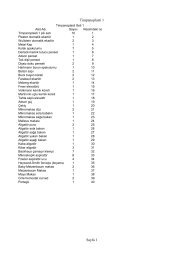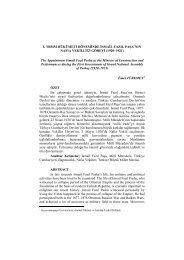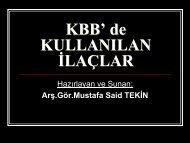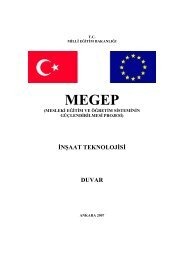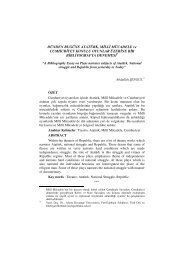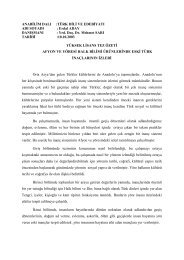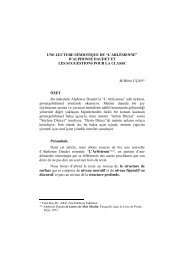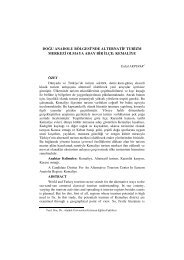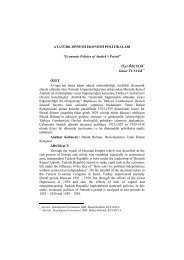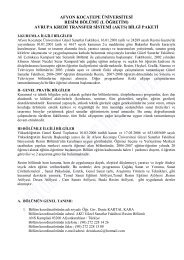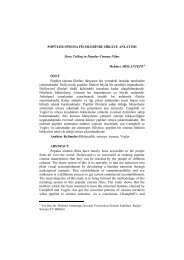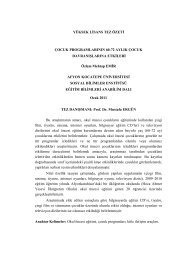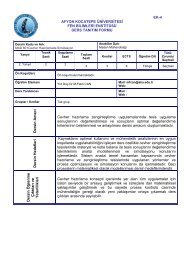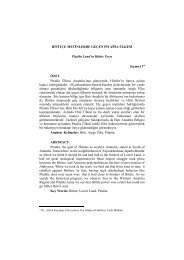You also want an ePaper? Increase the reach of your titles
YUMPU automatically turns print PDFs into web optimized ePapers that Google loves.
20<br />
Sosyal Biliml<strong>er</strong> D<strong>er</strong>gisi<br />
morphology knowledge to the extend that morphemes can be distinguished<br />
from the simil<strong>ar</strong> ones. Thus, “Ar” (<strong>ar</strong>/<strong>er</strong>) morphemes from isomorphism<br />
w<strong>er</strong>e studied and exemplified.<br />
Key words: Turkish, isomorphism, “Ar” (<strong>ar</strong>/<strong>er</strong>) morphemes.<br />
GİRİŞ<br />
Biçim biriml<strong>er</strong> (morfeml<strong>er</strong>) bağımlı (ekl<strong>er</strong>) ve bağımsız (sözcük)<br />
olmak üz<strong>er</strong>e ikiye ayrılır. Türkçe yapısı bakımından sondan eklemeli bir dil<br />
olduğu için bağımlı biçim biriml<strong>er</strong>i (ekl<strong>er</strong>) açısından zengindir. Bu bağımlı<br />
biçim biriml<strong>er</strong>i bir yandan yeni biçim biriml<strong>er</strong>i yap<strong>ar</strong>ken, diğ<strong>er</strong> yandan da<br />
biçim biriml<strong>er</strong>i <strong>ar</strong>asında ilişki kur<strong>ar</strong>l<strong>ar</strong>. Üz<strong>er</strong>ine geldikl<strong>er</strong>i bağımsız biçim<br />
biriml<strong>er</strong>ine ses bakımından uyum sağladıkl<strong>ar</strong>ı için çok biçimlidirl<strong>er</strong>. Bunl<strong>ar</strong>;<br />
Türkiye Türkçesinde en az 2, en fazla 8 değişik biçime sahiptirl<strong>er</strong>. Bağımsız<br />
biçim biriml<strong>er</strong>i yapısı bakımından basit, türemiş ve birleşik olmak üz<strong>er</strong>e üçe<br />
ayrılır. Bağımsız biçim biriml<strong>er</strong>i bağımlı biçim biriml<strong>er</strong>inin t<strong>er</strong>sine tek<br />
biçimlidir.<br />
Türkçenin, t<strong>ar</strong>ihsel süreç iç<strong>er</strong>isinde g<strong>er</strong>ek ses yönünden gelişme<br />
göst<strong>er</strong>mesine ve g<strong>er</strong>ekse başka dill<strong>er</strong>le sözcük alış v<strong>er</strong>işine bağlı ol<strong>ar</strong>ak<br />
biçim biriml<strong>er</strong>i <strong>ar</strong>asında biçimsel benz<strong>er</strong>likl<strong>er</strong> de <strong>ar</strong>tmıştır. V<strong>ar</strong>d<strong>ar</strong>,<br />
Açıklamalı Dilbilim T<strong>er</strong>iml<strong>er</strong>i Sözlüğü’nde “Eşadlılık göst<strong>er</strong>en sözcükl<strong>er</strong>”e<br />
eşadlı (Alm. Homonym, Fr. homonyme, İng. Homonymous) (1998: 96-97),<br />
“Göst<strong>er</strong>ileni ayrı, göst<strong>er</strong>eni özdeş olan sözcükl<strong>er</strong>in özelliği”ne eşadlılık<br />
(Alm. Homonymie, Fr. homonymie, İng. Homonymy) (1998: 97); “Eşseslilik<br />
göst<strong>er</strong>en sözcükl<strong>er</strong>”e eşsesli (Alm. Homophon, Fr. homophone, İng.<br />
Homophonous), “Kimi dill<strong>er</strong>de görülen yazılışı ayrı, söylenişi aynı olan<br />
sözcükl<strong>er</strong>in özelliği”ne eşseslilik (Alm. Homophonie, Fr. homophoneie, İng.<br />
Homophony) (1998: 99); “Eşyazımlılık göst<strong>er</strong>en biriml<strong>er</strong>”e eşyazımlı (Alm.<br />
Homograph, Fr. homographe, İng. Homographic), “Kimi dill<strong>er</strong>de görülen,<br />
söylenişi ayrı, yazılışı aynı olan göst<strong>er</strong>gel<strong>er</strong>in özelliği”ne eşyazımlılık (Alm.<br />
Homograph, Fr. homographe, İng. Homographic) (1998: 100) d<strong>er</strong>. Ayrıca<br />
V<strong>ar</strong>d<strong>ar</strong> “Öte yandan, dilbilimcil<strong>er</strong> eşadlılık olgul<strong>ar</strong>ıyla çokanlamlılık<br />
olgul<strong>ar</strong>ını ayırmaya özel bir özen göst<strong>er</strong>mekte, t<strong>ar</strong>ihsel, kökensel ölçütl<strong>er</strong><br />
y<strong>er</strong>ine eşsüremli ilkel<strong>er</strong> uy<strong>ar</strong>ınca işlem yap<strong>ar</strong>ak eşadlılığın sınırl<strong>ar</strong>ını<br />
genişletmektedirl<strong>er</strong>.” (1998: 97) diy<strong>er</strong>ek kökenl<strong>er</strong>ine bakılmaksızın<br />
anlaml<strong>ar</strong>ı f<strong>ar</strong>klı, yazılışl<strong>ar</strong>ı/söylenişl<strong>er</strong>i aynı yapıl<strong>ar</strong>ın bu kapsamda<br />
değ<strong>er</strong>lendirildiğini belirtmektedir. Korkmaz da “Söyleniş ve yazılışl<strong>ar</strong>ı<br />
biribirinin aynı olup da anlaml<strong>ar</strong>ı (veya görevl<strong>er</strong>i) ve göst<strong>er</strong>dikl<strong>er</strong>i kavraml<strong>ar</strong><br />
açısından biribirl<strong>er</strong>iyle hiçbir ilişkisi bulunmayan ek ve kelimel<strong>er</strong>”e eş sesli<br />
(ek, kelime), “Ayrı anlam veya görevdeki kelime ve ekl<strong>er</strong>in ses ve yazılış<br />
bakımından aynı olmal<strong>ar</strong>ı durumu”na eş seslilik (1992: 57-58) diy<strong>er</strong>ek<br />
***



